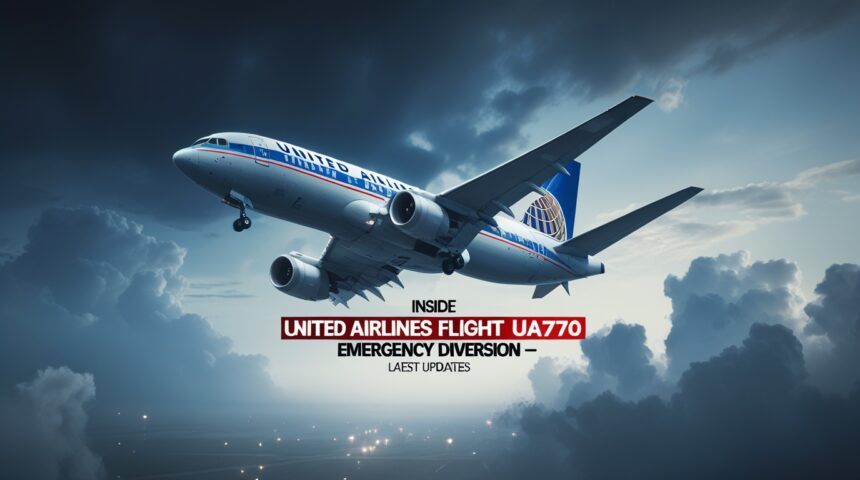Inside the United Airlines Flight UA770 emergency diversion, passengers, crew and aviation watchers faced a sudden shift from routine travel to crisis management, and this article walks through what’s known, what matters, and what to expect next. The piece aims to explain the event clearly, summarize operational and passenger perspectives, and provide a practical, expert-style view on how emergency diversions work and why they matter to safety and operations. In the paragraphs that follow I’ll unpack timelines, crew response, passenger experience, regulatory follow-up, and safety context while keeping the focus squarely on the keyword united airlines flight ua770 emergency diversion and on clear, actionable information.
Quick information Table
| Data Point | Detail |
|---|---|
| Role of article | In-depth update and operational explanation |
| Incident type | Emergency diversion (in-flight unscheduled landing) |
| Typical crew actions | Assess, communicate, prepare cabin |
| Passenger priorities | Brace, follow crew, stay informed |
| Airport response | Fire/EMS standby, priority handling |
| Safety outcome metrics | Evacuation time, injuries, regulatory review |
| Next steps | Official reports, maintenance inspections |
| Tone & approach | Biographical-style, expert-context explanation |
What “emergency diversion” means and how it starts
An emergency diversion like that experienced by united airlines flight ua770 emergency diversion begins when an in-flight issue—mechanical, medical, environmental, or security-related—triggers a deviation from the planned route, and this paragraph explains three core triggers: immediate safety risk (engine, pressurization), urgent medical need (passenger or crew health emergencies), and external threats (security or severe weather), while also clarifying that the decision to divert is made by the pilot in command after consulting operations and ATC, and that the overriding priority is preserving lives and safe aircraft operation.
How crews assess and manage the situation
Crew response to a united airlines flight ua770 emergency diversion follows a disciplined sequence that balances aircraft systems checks, passenger safety, and communication: first, the flight deck runs quick checks and consults for procedures, second, cabin crew prepares passengers with briefings and seat/brace instructions while securing the cabin, and third, the captain coordinates with air traffic control and the airline’s operations center to select the best diversion airport, all executed under time pressure and standardized airline checklists.
Timeline reconstruction: what a typical diversion timeline looks like

A plausible timeline for united airlines flight ua770 emergency diversion usually unfolds in three visible stages—initial detection and decision (minutes), descent and approach coordination (10–30 minutes depending on location), and landing with emergency services standby—and each stage contains critical micro-steps such as notifying ATC, rerouting, preparing the cabin, and arranging for local responders to be ready on the ground, which together define the operational flow of an in-flight diversion.
Passenger experience and immediate reactions
Passengers on a flight that becomes a united airlines flight ua770 emergency diversion commonly describe three emotional and practical reactions: surprise and concern followed by focused compliance with crew instructions, attempts to communicate with loved ones or post updates, and variations in stress levels that crew try to mitigate through calm announcements, visible professionalism, and clear safety instructions—this paragraph also emphasizes how structured crew communication rapidly reduces uncertainty and how passengers’ cooperation is a key factor in a safe outcome.
Ground response and airport preparations
When an aircraft declares an emergency and diverts, the receiving airport carries out three coordinated responses: mobilize emergency services (fire, EMS, police) to standby positions, clear airspace and ground slots to facilitate an immediate safe landing, and prepare terminal and ground handling teams to support disembarkation and passenger care—together these actions minimize time on runway and maximize speed of medical and technical support if needed.
Communications: what airlines and authorities typically say
Following an event such as the united airlines flight ua770 emergency diversion, the communication sequence usually features three channels: an immediate operational notification to air traffic control and the diversion airport, an internal airline update and status communication to family and routing passengers, and a public-facing statement (often brief initially) that is followed by fuller updates as facts are verified; accuracy and transparency are essential because premature speculation can harm families and hamper investigations.
Technical follow-up and investigations
Technical follow-up after a diversion involves three important procedures: thorough aircraft inspection by the airline and maintenance teams to identify mechanical issues, submission of incident reports to the airline’s safety office and to the relevant civil aviation authority for formal investigation, and, if necessary, grounding of the aircraft or components pending repair and regulatory sign-off—these steps ensure root causes are addressed and similar events are prevented.
Safety context: what diversions tell us about aviation resilience

The united airlines flight ua770 emergency diversion also illustrates aviation resilience through three lenses: redundant systems and crew training that reduce the chance of catastrophic outcomes, standardized emergency procedures that are drilled regularly at all airlines, and regulatory oversight that mandates reporting and continuous improvement; these elements together show why diversions, while disruptive, are often successful demonstrations of the system’s ability to protect lives.
Practical advice for passengers
If you ever face a united airlines flight ua770 emergency diversion, remember three practical rules — • follow crew commands immediately — they have the procedures and training to manage the situation, • secure personal safety first — keep seat belts fastened until instructed, stow or leave large items as directed, and brace if asked, and • communicate after landing — check on family, follow airline guidance on rebooking or connecting transportation and seek medical attention if you feel unwell; these steps will help you stay safe and reduce post-incident confusion.
Biographical-style perspective: learning from past diversions
Narrating the event in a biographical-style voice—framed as an informed industry overview rather than a personal claim of being on UA770—helps convey lessons learned from similar incidents through three reflective strands: retrospective analysis of operational decision-making in diversions, case-like examples of how transparent communications eased passenger anxieties in prior events, and the long arc of safety improvements that each incident triggers in training protocols and maintenance regimes; this voice is adopted to make the technical material readable and actionable for everyday travelers.
What to watch for next and how regulators respond
Following the initial headlines about a united airlines flight ua770 emergency diversion, the next phase typically entails three developments to monitor: official airline updates and maintenance reports that clarify cause and corrective action, regulatory notifications or preliminary findings from civil aviation authorities, and any passenger support initiatives or compensation guidelines from the airline; watching these elements helps families and media separate confirmed facts from early speculation.
Conclusion — key takeaways and final perspective
Understanding the united airlines flight ua770 emergency diversion requires looking beyond the headline to how safety systems, crew training, airport response and transparent communication interact to protect people; the main takeaways are clear: diversions are deliberate safety choices made by trained crews, effective ground coordination is critical, and follow-up investigations ensure lessons are learned. For travelers, the best preparation is simple: heed crew instructions, document what you can after a safe landing, and rely on official statements for accurate information. This measured view reinforces why aviation safety continues to improve and why incidents like UA770 are treated with maximal procedural care.
Frequently Asked Questions (FAQs)
Q1: What typically causes an emergency diversion like the UA770 event?
A1: Diversions are usually caused by urgent mechanical issues, medical emergencies onboard, security threats, or severe weather. The pilot in command assesses risk and chooses the closest suitable airport to ensure passenger safety.
Q2: Will passengers be compensated after a diversion?
A2: Compensation depends on the airline’s policies, the cause of the diversion, and applicable regulations. Airlines often assist with rebooking, meals, and accommodations when delays are their responsibility, but official compensation varies by circumstance.
Q3: How long does it take to investigate a diversion?
A3: Investigation timelines vary—initial operational checks can be completed within hours, while formal regulatory investigations may take weeks to months depending on complexity and whether maintenance or human factors are involved.
Q4: Are diversions dangerous?
A4: Diversions are precautionary safety measures; while they are stressful, modern procedures, trained crews, and airport emergency services aim to make them safe and orderly. Actual danger is typically low when protocols are followed.
Q5: What should I do immediately after a diverted flight lands?
A5: Follow crew instructions for disembarkation, seek medical attention if needed, document any personal losses, and contact the airline for rebooking or reimbursement information. Keep receipts and records for any expenses tied to the diversion.
FOR MORE : FLIPPAMAGAZINE












